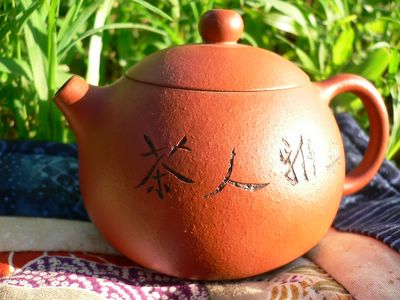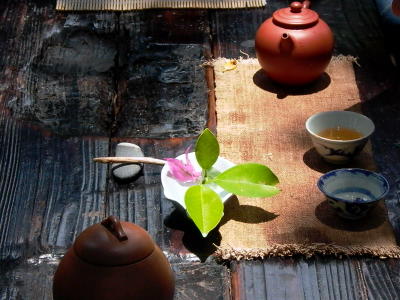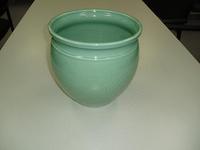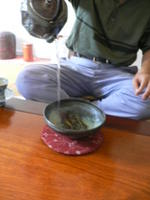I'm done with my first round of tasting these
8 tea samples:
a. Hong Tai Chang Cooked Pu'er, 1980s(?), Cooked - Hong Tai Chang Tea Company
b. Xia Guan Iron Pu'er Cake, 2002, Uncooked - Xia Guan Tea Factory
c. Chongqing Tuocha, early 90s, Mix(?) - Sichuan
d. Xishuangbanna Pu'er Cake, 2003, Uncooked - Chang Tai Tea Company
e. YiWu region Wild Grown Pu'er, 2003, Uncooked - Xinghai Tea Factory
f. Long Yuan Label Pu'er, 2002, Uncooked - Dadugang Tea Factory
g. Dayi Label 7542 Pu'er, 2000, Uncooked - Menghai Tea Factory
h. Jingmai Region, wild Grown Pu'er, 2003, Uncooked - 6 Famous Tea Mountain Co Ltd
Some fellow taster has suggested a form to evaluate each brew. I have used the one designed by Teaparker. I will write one in detail and be more brief for the others.

a. Tea name: Hong Tai Chang Cooked Pu'er
Harvest: 1980s(?)
Place: Border of Yunnan, Hong Tai Chang Tea Company
Price: ?
Accessories: a white, thin gaiwan and white cups (see picture)
Water Quantity: 10 cl.
Water: Mineral water Yes, Taiwan.
(I have used the same water and tea set for all my tastings. Here is
why.)
A. View
- Dry leaves: big, whole, well flaked
- Color of dry leaves: brownish, a few white spots
- Color of the tea: brown, some shine
- Clarity: Good
- Wet leaves: closed, didn't unfold flat
B. Smell
- Dry leaves: old, moldy
- The cover of the gaiwan: attacks the nose, like pepper
- Tea: small dried fishes
- Wet leaves: mold and wood
- Empty glass: flat, little smell
C. Taste
- Sweetness: A little
- Persistance: No
- Bitter/sour: a little nauseating.
- In the throat: I realize it upsets my stomach
- Dryness: Yes, a little
Other observations/conclusion: this cooked pu-er is not a pleasant tea for me. The well falked leaves made it round, but the smells were not pleasant and the taste a little nauseating.
Let's continue with the other teas:
b. Xia Guan Iron Pu'er Cake, 2002, Uncooked - Xia Guan Tea Factory
A. View: broken, reddish dry leaves resulting in a darker orange brew,
B. Smell: dry straw turns to sweet cigarette butt and ashtray. Deep smoky.
C. A little sweetness at the end, very bitter and concentrated. Slowly turns dry and sweet after a minute or 2.
Not a pleasure.
c. Chongqing Tuocha, early 90s, Mix(?) - Sichuan
A. Small, blurred leaves with mold and very dark. Gives a dark brown brew.
B. Dry wood becomes wet, mellow wood with smell of underground storage.
C. Little sweetness, average persistance, but bitter at the back of the tongue. Unpleasant dryness, but long finish.
The smokiness due to fry pan drying has receded, but still not very pleasant. Plus: has a strong cha chi and long finish.
d. Xishuangbanna Pu'er Cake, 2003, Uncooked - Chang Tai Tea Company
A. Light dry leaves of darker color give a brown orange, clear and shiny brew
B. Dry it smells sweet, but brewed there are then smells of amonia, cigarette butt, earth & mud
C. This undrinkable Sh.t feels watery and overly bitter with no dryness.
Horrible!
e. YiWu region Wild Grown Pu'er, 2003, Uncooked - Xinghai Tea Factory
A. Heavy, greenish leaves bive a yellow orange brew
B. Dry straw smell becomes cheesy, and displays its YiWu origin. Light smells
C. Little, quickly disappearing sweetness. Somewhat sour, but not bitter. Flowery and long finish.
Got more lucky with the Yi Wu region. Has some potential to get better.
f. Long Yuan Label Pu'er, 2002, Uncooked - Dadugang Tea Factory
A. Long, solid and sharp, greenish and shiny leaves brew orange with residues.
B. Grass and light cigarette/wet pipe smell
C. Little sweetness. bitter sour. Turns sweet in the finish.
The smoky smells were not overwehlming and was almost drinkable.
g. Dayi Label 7542 Pu'er, 2000, Uncooked - Menghai Tea Factory
A. Shiny small buds on the outside and older leaves below gives a shiny and clear brew.
B. Smoky, pipe and mushrooms. Light nice smell that turns cheesy (good for me, I'm French!)
C. Light sweet taste without bitterness. Turns dry under the tongue.
Sweet and smooth pu-er, just too bad it has also this smoky, cigarette smell, albeit lighter than the other samples.
h. Jingmai Region, wild Grown Pu'er, 2003, Uncooked - 6 Famous Tea Mountain Co Ltd
A. Small buds of light color give a light yellow/orange brew
B. A little straw and mellow, light, humid forrest and sweet light smokiness
C. A little sweet in the beginning and then again during the finish. A little sour in the back of the mouth and bitter above the tongue. Dry, long and sweet.
This is the best pu er of this sampling and by far! And it's a wild grown pu er from a famous mountain. Well, good trees in old producting regions make good teas! The world is sane after all!
Let me again thank this friend in Singapore who made this tasting possible. I am actually glad to have tasted so many bad pu erhs (for free!) Only one out of these eight puer (already selected by a very experienced connaisseur) would have made it to my selection. That says a lot, I think, about the difficulty to find really good pu-erh. And it also shows that age is not a fool proof criteria either! Even 'wild grown' is not a sure thing (see e.). The only thing you can trust are your senses!
Now, I guess some will find that I am too harsh on some of the teas. They may think that I didn't appretiate their character. Maybe. Smokers may find them appealing and give them fancy names like "camel breath"! But my senses tell me it doesn't taste right and I just say so.

 Early readers of this blog will remember Master Gu, Chuan Ze (scroll down a bit). We met again last Sunday, during the 'Taiwan old tea' event. He proudly showed me his latest work: a big cup for oolong tea.
Early readers of this blog will remember Master Gu, Chuan Ze (scroll down a bit). We met again last Sunday, during the 'Taiwan old tea' event. He proudly showed me his latest work: a big cup for oolong tea. 

 Dimanche dernier, Teaparker n'a pas seulement amener ses propres ustensiles à la dégustation de vieux thé, il a également amené son eau!
Dimanche dernier, Teaparker n'a pas seulement amener ses propres ustensiles à la dégustation de vieux thé, il a également amené son eau! 
 It happened Sunday 25, and I was there! Below this article, I already posted more pictures yesterday. In the meantime, Teaparker has also written an article about this big tea party with over 200 participants in the full red playhouse, in the Simeding district.
It happened Sunday 25, and I was there! Below this article, I already posted more pictures yesterday. In the meantime, Teaparker has also written an article about this big tea party with over 200 participants in the full red playhouse, in the Simeding district.
 How are we then to appretiate old tea?
How are we then to appretiate old tea? (One of my tea classmate at Teaparker's study).
(One of my tea classmate at Teaparker's study).


 Yesterday, I once again tasted my 1985 wild Tuocha. But instead of drinking it on a chair, I decided to get in a more traditional gongfu cha position: on a pillow on the floor and the tea set on a small table in front of me. I know I am still behind with detailed tasting notes on this tea, but I wanted to enjoy it, not study it. I even put some old Chinese music on my stereo. Then I was gone, flying through time and distance, embracing the world from my small apartment. My mind was clear, I could see what matters in my life and felt uplifted.
Yesterday, I once again tasted my 1985 wild Tuocha. But instead of drinking it on a chair, I decided to get in a more traditional gongfu cha position: on a pillow on the floor and the tea set on a small table in front of me. I know I am still behind with detailed tasting notes on this tea, but I wanted to enjoy it, not study it. I even put some old Chinese music on my stereo. Then I was gone, flying through time and distance, embracing the world from my small apartment. My mind was clear, I could see what matters in my life and felt uplifted. The brewing method follows the general principles of gongfu cha:
The brewing method follows the general principles of gongfu cha: a. Tea name: Hong Tai Chang Cooked Pu'er
a. Tea name: Hong Tai Chang Cooked Pu'er We used quite a large amount of leaves and filled the silver teapot about half way. Guess how many tasty, mind blowing, interesting brews we made? 11!
We used quite a large amount of leaves and filled the silver teapot about half way. Guess how many tasty, mind blowing, interesting brews we made? 11! 
 Durant la dynastie Tang (618-907), Lu Yu fut le premier à étudier la question. A l'époque, le thé était cuit et de couleur verte, transparent. Pour Lu Yu, les bols verts (voir la photo du réceptacle d'eau ci-contre) sont ceux qui rendent la couleur du thé la plus éclatante. Faites l'expérience avec un bol blanc aussi, et vous verrez que le blanc enlève son éclat au thé.
Durant la dynastie Tang (618-907), Lu Yu fut le premier à étudier la question. A l'époque, le thé était cuit et de couleur verte, transparent. Pour Lu Yu, les bols verts (voir la photo du réceptacle d'eau ci-contre) sont ceux qui rendent la couleur du thé la plus éclatante. Faites l'expérience avec un bol blanc aussi, et vous verrez que le blanc enlève son éclat au thé. Durant la période Song (960-1279), on buvait surtout du thé vert en poudre, le matcha japonais actuel. C'est un thé de couleur verte, mais pas transparent. La meilleure couleur est le noir. C'est pourquoi on utilisait les bols Tianmu noirs à l'époque et aujourd'hui encore.
Durant la période Song (960-1279), on buvait surtout du thé vert en poudre, le matcha japonais actuel. C'est un thé de couleur verte, mais pas transparent. La meilleure couleur est le noir. C'est pourquoi on utilisait les bols Tianmu noirs à l'époque et aujourd'hui encore.  La méthode pour infuser le thé suit les principes du gongfu cha:
La méthode pour infuser le thé suit les principes du gongfu cha: